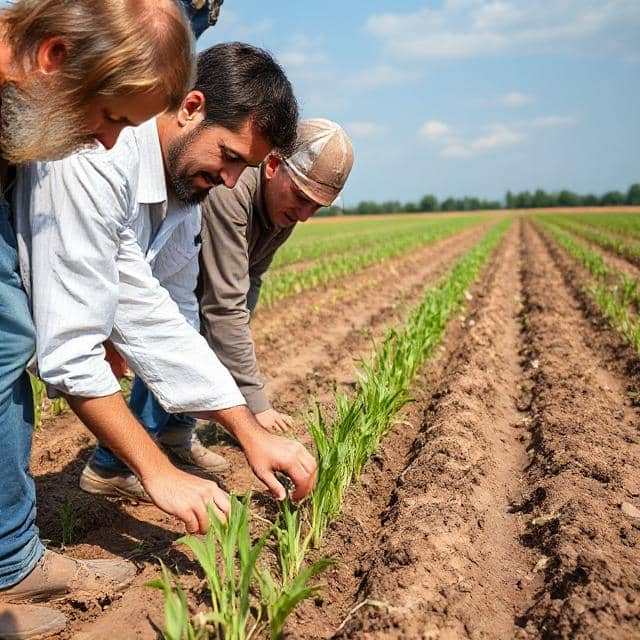AI for Soil Testing: Why the Next Five Years Will Be More Hype Than Help
It seems to be the hot topic at the moment. Artificial intelligence (AI) is everywhere right now. Its being used to predict the weather to agronomic models, and the turf industry is no exception. Some companies even seem to be looking at the use of AI for Soil testing.
We’re being told by some folks that AI will soon predict nutrient deficiencies before they happen, interpret complex soil tests, and even optimise fertiliser programs in real time.
The strange thing about this data based approach is that in many instances it appears to be driven by companies who sell fertilisers to make money, and have an army of sales reps to do this. Go figure!
It all sounds really impressive. In reality though, AI is still a long way from being able to replace a qualified agronomist’s experience, intuition, and local knowledge.
As with most things AI, when it comes to predictive models and the interpretation of a soil test, the technology isn’t quite as good as we are lead to believe.
What AI-driven Soil Analytics Can Do.
- Quickly process large datasets and then highlight any patterns or anomalies.
- Provide nutrient reports based on established ratios (e.g., Ca:Mg, K:Na).
- Generate predictive models for growth potential or the chances of a deficiency occuring under set conditions.
- Help in long-term data management and benchmarking between sites.
Where AI For Soil Testing Falls Short.
AI relies heavily on fixed data inputs and general agronomic models. However, as we are all well aware turf and soil systems are complex. Subtle changes in the environment or their management can completely change how you end up interpreting the data..
AI cannot (yet):
- Make allowances for variations in the soil texture, drainage rate, and any soil layers (e.g., sand profiles vs native soils).
- Evaluate interactions between the evapotranspiration rate, rainfall, or the localised climate.
- Interpret historical management practices, and their impact on the soil. Fertiliser timing, irrigation water quality, wetting agent use, or aeration all impact the soil and the nutrient status.
- Recognise any site-specific biological interactions that may exist.
- Take into account what playability outcomes you may need for different turf areas (greens vs fairways vs sports fields).
In short, AI is great to describe what the numbers are but not always why they matter.
The Weakest Link: Data Quality.
The results you get when you use AI for soil testing entirely depend on the quality of data that it learns from, and that’s where the problem starts.
Soil testing data is messy. For example the following are just a few factors that impact on the results that you get:
- Sample depth. How many times have you seen a sample taken from a consistent depth?
- The time of year that you sample.
- Soil moisture content when you test the soil.
- The amount of rainfall/irrigation prior to taking samples.
- How recently you apply fertiliser before you carry out a test.
- The lab that you use to carry out a test.
No matter what companies my tell you, this high degree of inconsistency makes it difficult for any AI system to build reliable models.
Without clean, standardised data from thousands of sites, the predictive accuracy of an algorithms remains limited. The old rule still applies: you get out what you put in!
Soils Aren’t Static Datasets.
AI models are great at being able to spot correlations. The problem with soils is that they aren’t static systems.
Soils are dynamic, living ecosystems that respond to management, climate, and biology. Nutrient leaching, microbial activity, and the structure and nature of a rootzone can change over time.
A machine learning model that is trained on historical data may at first perform well. However, over time it will quickly lose any relevance to what actually happens when any conditions change.
The complexities of soil–plant–microbe interactions are something current AI systems for soil testing simply don’t understand.
A good example of this is nitrogen (N) cycling in a sand-based rootzone. The low cation exchange capacity (CEC) of a sand reduces the ability of the rootzone to retain ammonium, and nitrifying bacteria will tend to dominate due to high aeration. This increases the chances of nitrate leaching.
You Need Humans to Interpret Data Properly.
A good doctor doesn’t just doesn’t just read numbers from a blood test to find out what might be wrong with a patient. Likewise, a good agronomist doesn’t just read soil test numbers to identify what issues may exist.
They factor in the turf type, the time of year, the climate, the irrigation regime, and the site’s management history.
AI is great to identify trends or anomalies, but it can’t interpret why those patterns exist or what they mean in real terms.
For example, a low potassium soil may come up as “deficient” in an AI system, but a turf agronomist with local experience might know that it’s normal for that sand profile and the turf still performs well.
Context matters and AI doesn’t have it.
Sssshhh! It’s a Secret.
One of the biggest advantages with human interaction is that humans can explain why they come to their conclusions.
AI prediction models generally can’t do this. Instead they spit out recommendations, and hide the logic behind them in thousands of algorithmic layers. They are basically a secret ‘black box’.

When you’re potentially going to spend a significant amount of money on soil amendments or fertilisers that’s a big problem. Sometimes “the computer told me’ just ain’t going to cut the mustard!
How can you trust a computer model if it can’t tell you why it’s making a recommendation?
This is especially true in sand based rootzones where small changes in soil chemistry can have big affects later down the track.
The Use of AI For Soil Testing will be as an Assistant, Not an Agronomist.
Undoubtedly, over the next five years, AI will improve how we handle data. It already can help clean up results, and detect patterns faster.
However, the idea that it will “interpret” soil tests or accurately predict in the future how nutrients will behave in a soil, is optimistic at best.
Good agronomists will be those who learn to use AI as a decision support system, and not to replace good science.
Im not anti-AI. Far from it. But people need to be realistic with what it can and can’t do when it comes to soil testing (and may other things when I think about it). Think of it as another diagnostic tool like disease test kits or TDR sensors.
These tools are valuable when you use them properly but can potentially become very expensive when you trust them implicitly.
The use of AI for soil testing will make good agronomists more efficient but not obsolete. The key here is in the “good agronomist” part. If you intend to rely 100% on AI to make decisions maybe its time you should look for another job?
The real value lies in when you combine human insight with smart tools, and don’t hand decision-making over to algorithms.

Jerry Spencer
Jerry has an Hons Degree in Soil Science (1988) from Newcastle Upon Tyne University. He then worked as a turf agronomist for the Sports Turf Research Institute (STRI) until 1993.
He gained a Grad Dip in Business Management from UTS in 1999. He has held a number of technical roles for companies such as Arthur Yates (Commercial Technical Manager) and Paton Fertilizers (Organic, turf specialty and controlled release fertiliser) portfolios.
In 2013 he established Gilba Solutions as independent sports turf consultants and turf agronomists. Jerry has written over 100 articles and two books on a wide range of topics such as Turf Pesticides and turfgrass Nutrition which have been published in Australia and overseas.

